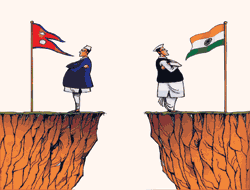 Since the 1996 Indo-Nepal trade treaty, Nepal's exports to India have grown five-fold to about Rs 25 billion. But renewal of the treaty, which expires at midnight on 5 December, appears to be in jeopardy.
Since the 1996 Indo-Nepal trade treaty, Nepal's exports to India have grown five-fold to about Rs 25 billion. But renewal of the treaty, which expires at midnight on 5 December, appears to be in jeopardy. Officials from the two countries have met four times to iron out the main sticking point: India's worry that there has been an unnatural increase in exports of certain items, suggesting that these are third-country goods pretending to be Nepali products. "There has been absolutely no progress on the two main issues: rules of origin and safeguards against surge," one negotiator told us.
Here\'s where the negotiations are stuck:
- India has proposed two formulae to change the rules of origin: either capping imported material content, or fixing local value addition.
- India also wants a safeguard clause giving it the power to suspend and eventually cancel preferential treatment for the product in question.
Nepali negotiators seem undecided on how to respond, and also about the nature of the technicality we want in place. Commerce Minister Purna Bahadur Khadka even took the same flight back to New Delhi from Doha with his Indian counterpart Murasoli Maran to see if he could untie the knot. Officials say that unless there was a political breakthrough at the Khadka-Maran talks, it is unlikely that the treaty can be salvaged.
Meanwhile, the Indians have been turning on the heat. They nearly walked out of the last round of joint secretary level talks "because nothing was moving". Nepal apparently had no response at the talks to the Indian proposal for a 50 percent cap on imported material content on our exports to India, or a 50 percent local value addition threshold. At present there is a roughly 20 percent value addition requirement for goods seeking duty-refunds on exports to Indian markets.
Nepali officials who had initially opposed a formula on value addition proposed by Nepal's Federation of Nepalese Chambers of Commerce and Industry (FNCCI) and India\'s Confederation of Indian Industry (CII), are now said to have decided that could be the way to go. But India now wants value-addition calculation done differently.
Indian officials are under pressure from their manufacturers of vegetable ghiu, acrylic yarn, copper wires and steel pipes, who say a surge in Nepali exports of these items since 1996 has destroyed their business. They've already lobbied for anti-dumping duties on acrylic and zinc oxide and local taxes in some states. They say the Nepali products have high third-country content, and there has been
an explosion in the entry of these items into India.
The Indians had been complaining about this for about a year, but it appears that Nepal failed to gauge the extent of Indian anger about the 1996 treaty. "Now we are trapped," says industrialist Binod Chaudhary. "If the government accepts the Indian proposal, trade will regress to pre-1996 and our exports will be doomed."
Others argue that a few exporters who benefit from questionable "exports" are holding Nepal's trade with India hostage, and sabotaging the country's industrialisation.


